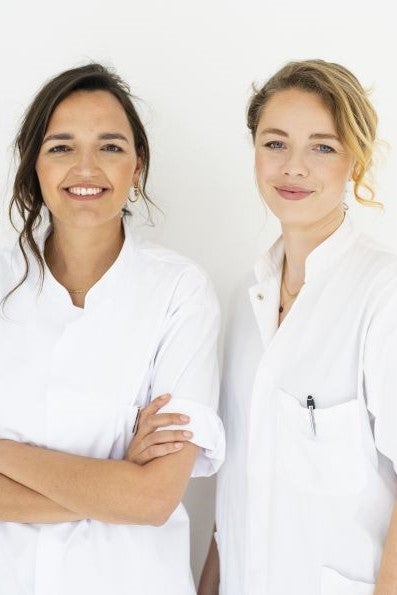Text: Jasmijn van Holsteijn | 16 July 2025
As medical students at VU Amsterdam, Romée and Veerle were struck by the sheer number of textbooks they were expected to read. Surely, there had to be a better way. Together with a team of students, doctors and medical specialists, they created Compendium Geneeskunde: a clear and compact book series covering the full scope of medical disciplines. Following the release of a 2.0 edition in 2019, Romée and Veerle – both qualified doctors by now – have launched a revised 2.0+ edition in June 2025. We spoke to them about this updated version and their mission to make medical knowledge more accessible and easy to navigate.
The 2.0+ edition is more inclusive than its predecessors. When did you realise something needed to change?
Romée: “Three years ago, we came across an illustration by a Nigerian artist: a pregnant woman of colour. That image really opened our eyes. All the illustrations in our book series featured white people, something that is still the case in most medical textbooks worldwide. But from a clinical perspective, that is simply not accurate. Skin conditions like chickenpox or eczema look completely different on darker skin. In order to treat patients effectively, it is vital that doctors can recognise those differences. We have paid close attention to this in the new edition.”
How else does the 2.0+ edition differ from previous editions?
Veerle: “The illustrations better reflect the diversity of the Dutch population. We also address the importance of inclusive language. When conducting a patient interview, for example, it is better to ask about ‘parents’ rather than ‘mother and father’. And we highlight gender-specific symptoms, because a heart attack, for instance, can present very differently in men and women.”
Romée: “Another blind spot we have addressed is the focus on hospital-based care in previous editions. That is what you mostly learn about during medical school and clinical placements. But in reality, the majority of medical graduates end up working outside of hospitals, as occupational physicians, insurance doctors, or addiction specialists, for example. That is why we have added a sixth volume to the series, entirely dedicated to extramural care.”
Have you also made changes based on feedback from readers?
Veerle: “Definitely. We really see Compendium Geneeskunde as the voice of all healthcare professionals. It is only by working together that we can keep the series truly up to date. When a reader contacts us to say, ‘This guideline has changed but it is not reflected in the book yet’, we will literally send them a cake. There are so few errors that we can afford to do that.”
Are there any study materials that complement the book series?
Romée: “Yes, we have developed an app that lets you test your medical knowledge by subject, using short clinical cases and quiz questions. It is useful for studying on the go, preparing for progress tests, or refreshing your knowledge ahead of BIG re-registration. We have also published twenty pocket editions, each focused on a specific medical specialty. They are designed for practical use and easy to carry in your pocket. Several of the editions have been translated into English and aligned with international guidelines. We now have readers in 96 countries!”
Where do you hope to be in ten years’ time with Compendium Geneeskunde?
Veerle: “I hope that nearly all healthcare professionals around the world will be connected through the knowledge we share via Compendium Geneeskunde, and that we will have built a true community through our books, pocket editions and app. The app and several pocket editions are already available in English. I can’t wait until we can translate the entire book series. But to do that, we will need a massive international network. So, any support is more than welcome.* We are constantly asking ourselves how we can make medical knowledge even more accessible. And we will keep doing that for the next ten years.”
* Want to help Romée and Veerle translate Compendium Geneeskunde to English? Contact them at info@compendiumgeneeskunde.nl.
Compendium Geneeskunde 2.0+ (in Dutch), the go-to reference work for medical students, doctors and specialists, is available to order at the Compendium Geneeskunde website.
